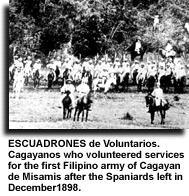| TravelSmart.NET
Archive Home |
|
| Inquirer.NET
Home |
|
| TravelSmart.NET
Home |
|

De Oro history written
by boy, 9, in 1899
By Agnes Paulita R. Roa
Cagayan de Oro City
 ONE of the priceless historical legacies that Cagayan
de Oro City possesses is a piece of document written in the early
century and mimeographed by Xavier University sometime in the
'60s. It is known as the ''Bautista Manuscripts.''
ONE of the priceless historical legacies that Cagayan
de Oro City possesses is a piece of document written in the early
century and mimeographed by Xavier University sometime in the
'60s. It is known as the ''Bautista Manuscripts.''
The document is a rare chronology of the history of Cagayan de Oro from the Spanish colonial times up to its revolutionary years during the Filipino-American War in 1900-01.
 The author, Filomeno Bautista, was a 9-year-old boy
who lived in Cagayan de Misamis (the city's old name) when the
town declared and celebrated its independence from Spain on Jan.
10, 1899.
The author, Filomeno Bautista, was a 9-year-old boy
who lived in Cagayan de Misamis (the city's old name) when the
town declared and celebrated its independence from Spain on Jan.
10, 1899.
The historical events of that era and the subsequent resistance war that the Cagayanons waged against the Americans were all witnessed and heard by Bautista. It moved him years later to write the book that chronicled this history of the town and Misamis province from the 1870s to 1901.
As written in the ''Bautista Manuscripts,'' the Spanish civil and military officials left Cagayan in haste in late 1898 after hearing of Gen. Emilio Aguinaldo's victory against Spain in Luzon.
The Spanish military governor of the huge Provincia de Misamis (comprising the present two Misamis provinces, Bukidnon, Camiguin, the two Agusans, the two Surigaos, Lanao del Norte, and Zamboanga del Norte with Cagayan de Misamis as the capital), left the administration of the town and the province to Filipino local officials who were chosen by the town's citizens in December 1898.
Prof. Mardonio Lao of Central Mindanao University in Bukidnon, author of ''Cagayan de Oro: 1622 to 1901,'' wrote that Aguinaldo sent emissaries to Mindanao who regularly contacted local officials. Through them, the Cagayanons were able to organize the local government based on the laws and regulations of the Malolos revolutionary government.
Bautista wrote that on Jan. 10, 1899, the public officials and citizens of Cagayan de Misamis declared independence from Spain and celebrated for two days with a ''parade, music, speeches and cannonades.''
The parade stopped at the Casa Real de Cagayan, which used to be the seat of power of Spanish colonial officials. In the balcony of that huge mansion stood Pedro Akut, who recited the poem ''Pinahanongod'' (Dedication) which was specially written for the occasion by Toribio Chaves, the new mayor.
Akut's rendition was said to have touched the hearts of his listeners. The words of the poem can truly evoke strong patriotic feelings even when read today. Below are excerpts of the poem from its original Visayan text:
''. . . Hiniktan tiil, kamot, ug hunahuna
Wa kita'y pamu-ot nga ka-ugalingon,
Mga katarungan ta dili pagatagdon,
Sa mga mapintas nga mga Katsila . . .
Oh! Cagayan, Cagayan de Misamis!
Itagsip sa inyong panumduman
Kining nueve ug dies sa Enero
Ning malipayong katu-igan . . .
Mil ochocientos ochenta y nueve
Ang pangilin sa malipayong pagsa-ulog,
Gitabu nga wa pa sugod mo-agi
Pagyokbo sa hinalangpong nasud . . .''
The city's Historical and Cultural Commission also possesses a rare photo of the parade's main float, the ''La Libertad de Filipinas,'' and was immortalized in the poem.
On the float stood a beautiful young maiden, Señorita Isidra Yamomo, holding the tricolor flag of the new republic which was to be hoisted for the first time that day.
The flag was sewn by sisters Agapita and Getulia Neri, daughters-in-law of Toribio Chaves.
Yamomo was standing on a broken chain symbolizing ''liberty.'' At her right was a young girl holding a laurel wreath signifying ''victory,'' and at her left, a young boy with a bolo representing ''defense.''
The fiesta of Jan. 10, 1899, also served as inauguration of the first Filipino officials of the then huge Misamis province and its capital, Cagayan de Misamis: Jose Roa y Casas, Provincial President; Manuel Corrales y Roa, Councilor for Peace and Internal Order; Pio Roa y Alcala, Councilor for Justice and Civil Registry; Ramon Neri y Abejuela, Councilor for Taxes and Property; and Toribio Chaves y Roa, Municipal President.
The Cagayanons enjoyed what it was to be governed by fellow countrymen for over a year. On March 30, 1900, the Americans came and took possession of the town and the province.
For sometime now, many have commented that Cagayan de Oro is bereft of any historical tradition and heritage. The events of Jan. 10, 1899 speak eloquently for itself, for through it the city scored three important historical milestones:
l The first to declare its independence in Mindanao.
l The first in Mindanao to hoist the tri-color flag of the new Philippine Republic.
l The first to install Filipino provincial and municipal officials in Mindanao after the Spanish era.
The day, however, did not write finis to the history of Cagayan de Oro. Its date was only the start of an unfolding drama of revolutionary exploits of local patriots.
Soon after 1899, particularly the following year, blood flowed in the streets and hills of Cagayan de Misamis, as Cagayanons fought to keep their freedom--another glorious chapter in the city's history when lives were sacrificed and fortunes were lost all for the sake of liberty.
Let not Cagayan de Oro forget Jan. 10, 1899.
___________________
Agnes Paulita ''Nanette'' Roa is a member of
the Cagayan de Oro Historical and Cultural Commission, and chairs
its committee on historical research.
![]()